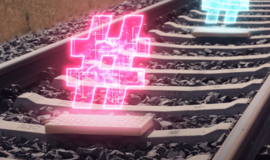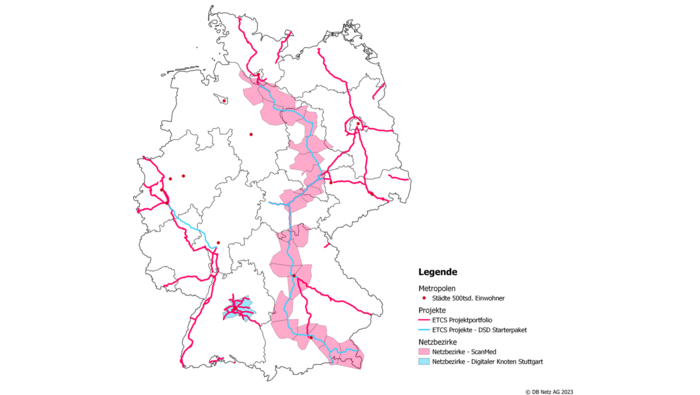
Infrastructure projects
The fundamental modernisation and digitalisation of infrastructure is laying the foundation for Digitale Schiene Deutschland. The nationwide rollout of the European Train Control System (ETCS) and digital interlockings (DSTW: Digitale Stellwerke) heralds a new era for the German rail network. These two technologies are key milestones on the path to the digitalisation of rail and will help to ensure that the German rail network continues to provide excellent service in the future.
The project portfolio of Digitale Schiene Deutschland includes the planning and implementation of around 50 DB Group projects implementing ETCS and/or DSTW as core components of digital control and safety technology (DLST: Digitale Leit- und Sicherungstechnik). Together with the starter package and the Fast Track Programme (SLP: Schnellläuferprogramm), the portfolio includes a variety of infrastructure projects – from the 3 km border crossing project to the Germany-wide corridor.
Project overview:
- border crossings, such as Passau – Austria or Aachen – Belgium,
- gap closures, such as Leipzig – Riesa or Limburgerhof – Ludwigshafen,
- rail junctions, such as the Basel node or the Ingolstadt node,
- corridors, such as the Corridor Rhine-Alpine or the Corridor Scandinavian-Mediterranean (ScanMed),
- other major projects, such as the Cologne – Rhine/Main high-speed line or German Unity Transport Project 8.3 (VDE 8.3, Berlin – Leipzig),
- other smaller projects, such as Rommerskirchen – Cologne-Ehrenfeld or Dresden –- Coswig.
The figure below shows the current ETCS project portfolio of Digitale Schiene Deutschland. This comprises around 30 % of the lines in DB InfraGO AG's comprehensive network and upgrade projects in 22 of its network districts.

The upgrade measures are speeding up in Germany, with ETCS having already been rolled out on more than 500 km of track to date (2023). Noteworthy projects include German Unity Transport Project 8.2 (VDE 8.2, Erfurt – Halle/Leipzig), the Wendlingen – Ulm line and the cross-border sections to Switzerland around Constance and Singen. Two DSTW in Annaberg-Buchholz and Warnemünde are now in service. More DSTW will follow as part of the fast-track programme, which will be implemented within a very short time in close cooperation with industry partners.
Large-scale installation of ETCS and DSTW begins with the starter package, which is made up of the Corridor ScanMed, the Cologne–Rhine/Main high-speed line (SFS KRM: Schnellfahrstrecke Köln-Rhine/Main) and the Stuttgart digital node.
Overall, infrastructure projects rolling out ETCS and DSTW are vital for the future of rail transport in Germany. Successfully implementing these projects will help to make rail infrastructure, and thus rail transport, more modern, reliable, efficient and environmentally friendly; this will meet the demands of a rapidly changing world.

